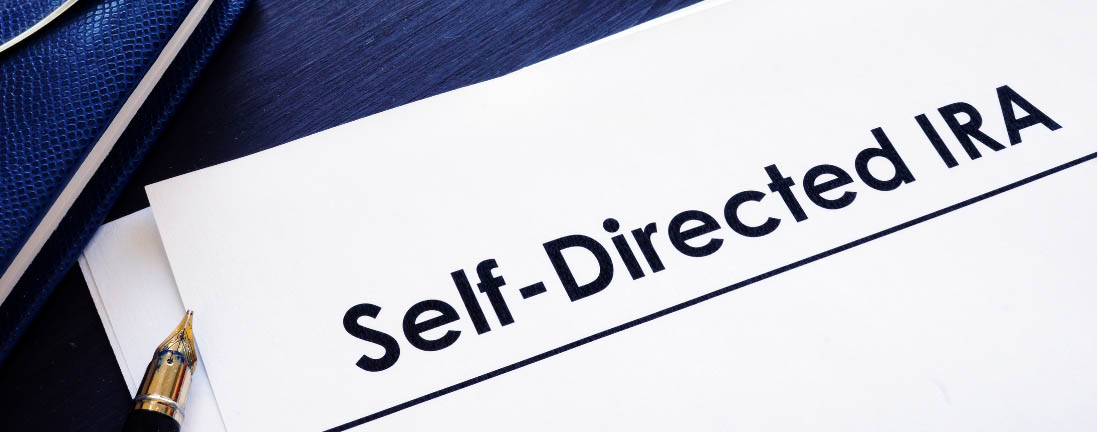An Individual Retirement Account is used by many Americans to save for retirement. These accounts are managed by a custodian or money manager. But what if you know about investing and want to be your own financial advisor?
Self Directed IRA Benefits
- Control
- Flexibility
- Tax Breaks
- Diversification
- FDIC Insured
No matter who you are, you probably have some inkling that a nest egg for the future is a good idea. Unfortunately, most people don’t know the first thing about making money grow, other than vague notions of the stock market and flipping homes. So, what most people typically do is let someone else manage that money for them. Usually, this involves contributing regularly to a retirement account. If you’re employed, that account will be a 401(k), and sometimes the company you work for will even match your contributions. If you’re self-employed, or if you already have a 401(k) but would like an additional retirement account, you would likely be interested in an independent retirement account, or IRA.
An IRA can take regular contributions, just like a 401(k), but you have no control over how the money is invested (and for most retail investors, that’s just fine). But what if you think you could manage your assets better than the money manager?
What is a Self Directed IRA?
A self-directed IRA is not the same as a Self Employed IRA or SEP IRA, although it can be. Rather, the self-directed nature of the IRA has to do with the fact that you, not the custodian holding the funds, are the money manager. They cannot give you any financial advice on what to buy, sell, or hold—you have to figure that out yourself.
5 Benefits of a Self Directed IRA
If you know what you’re doing, there are many benefits to opening a self directed IRA, including:
1. Control
In a regular IRA (whether that’s a traditional IRA or a Roth IRA), you have no say over how the money is managed. For most casual retail investors who don’t care about the difference between an ETF vs mutual fund, this is actually great. Though the popular adage of business wisdom says buy low and sell high, that’s rarely how people actually behave when it comes to the stock market. Instead, they buy when stock prices are up and sell them when they are down, acting after marketing activity.
But for individuals who understand how to pick long term investments, and especially ones who understand more complex concepts like options contracts, managing your own IRA may be preferable.
2. Flexibility
You can set up a self directed IRA as a Roth IRA or a traditional IRA, each of which has different tax implications. There are additional implications to the difference between them as well.
A traditional IRA has no income limits, but a Roth IRA does. If you make more than $125,000 in gross annual income, there are limits to how much you can contribute to a Roth IRA, and if you make more than $140,000, you can’t contribute to one at all (however, there are ways around this).
Withdrawing money from a Roth IRA before retirement carries no penalty, but you may have to pay taxes on the earnings if you are not 59.5 years of age and the account has existed for at least five years. Early withdrawals (before age 59.5) from a traditional IRA, on the other hand, are subject to taxes and penalties. Some of these differences are due to the different tax status of the different IRA types. Either way, you can select which type of IRA you want if you are setting up a self directed IRA to be managed at your discretion.
Free Strategy Session with an Anderson Advisor
Receive a detailed risk assessment to assist in lowering problem areas that could wipe out all of your assets with one wrong move. Speak with an Anderson Professional Advisor to get your FREE Strategy Session. Limited-Time offer: FREE (a $750 value.)
3. Tax Breaks
The contributions you make to a traditional IRA are not taxed, but when you make withdrawals during retirement, those will be taxed. It’s also possible for most people to write off the contributions to their traditional IRA against their current tax bill, which is in addition to the fact that the money will grow in a tax sheltered retirement account.
Contributions to a Roth IRA come after you have paid taxes (like FICA taxes from your paycheck), so you cannot write the contribution off. However, since you have already paid taxes on the money, your retirement distribution will be tax free.
While you may want to self direct your IRA, it’s not good to self direct your taxes. You should discuss your particular situation and financial goals with a qualified tax advisor who can help you learn how to pay less taxes. There are additional considerations, such as the fact that in select instances you may be able liquidate some of your retirement savings—for example, when you are a first-time home buyer.
4. Diversification
With a managed IRA (whether it’s a Roth or Traditional) the only asset class options are common securities, such as those traded on a marketplace, like stocks, bonds, CDs, mutual funds, ETFs, and in recent times (sometimes) cryptocurrency. By contrast, a self managed IRA facilitates much more diversification.
In addition to the aforementioned asset classes, someone with a self directed IRA can invest in precious metals (like gold and silver), commodities, business (either through privately issued shares called private placement or limited partnerships), real estate, and tax liens. Basically, a self directed IRA becomes a tax free place to invest in a variety of assets.
There are a few exceptions. As you might know, in more recent times, due to the advent of peer-to-peer app technology, it has become possible to invest in all sorts of interesting things, like famous pieces of art, collectibles (baseball cards or action figures), and even wine. There are even ways to invest in professional athletes and recognize gains on their performance (sort of like a fantasy sports team that actually pays off). However, none of these unconventional investment opportunities are supported in a self managed IRA, at least according to the IRS publication elaborating upon the internal revenue code.
5. FDIC Insured
Lastly, the benefit of a self directed IRA is not in contradiction to a regular IRA, but rather to the idea of no IRA at all. If you invest in any of the aforementioned assets, you may need to pay a capital gains tax (short term capital gains and long term capital gains) on the income these assets generate. By contrast, if they are placed in a self directed IRA, they can grow and generate income in a tax free setting until you are ready to withdraw them or pass them on to another person or account using IRA rollover rules.
Moreover, any type of cash-leaning asset, such as checking and savings accounts, CDs, and money market accounts in your self-directed IRA are FDIC insured against loss. This is a much better alternative to keeping your funds in places where they are not insured. Note that certain types of assets, like precious metals, securities, and real estate, are not FDIC backed, but you can purchase separate insurance policies for some of them.
How to Set Up a Self Directed IRA
You will need to find a bank or investment firm that can set up a self directed IRA up for you. Because you will be the money manager, there are no fees for money management that they can charge, making it less of a lucrative product for most banks.
Additionally, because the money is self directed, there is a greater risk of it shrinking, or in some disastrous cases, disappearing entirely, which is not an attractive outlook for a bank that takes deposits and loans them out to a third party seeking a mortgage or business loan.
That said, there are still companies that set up self directed IRAs, such as Equity Trust Company, Millennium Trust, Preferred Trust Company, and IRA Financial. You will need to do some research and see what’s available.
Note that just because a self directed IRA custodian isn’t charging for financial advice doesn’t mean there aren’t fees associated with leveraging an SDIRA custodian to hold your IRA funds. They will usually charge a setup fee and an annual fee for backend services, like filing legal paperwork and disclosures, record-keeping, reporting, and perhaps storing assets that require secure storage, such as precious metals.
How Do You Manage a Self Directed IRA
If you have an individual retirement account that is self managed, how do you go about directing that retirement fund to create a sizable nest egg? The answer is that you will have to seek out investment advice from books, articles, and experienced investors in your network. You will also have to learn about traditional investments, like stocks, bonds, and mutual funds.
If you choose to augment your IRA account with alternative investments, you’ll have to learn about those alternative assets as well. The IRA custodian you select to hold your IRA assets may offer a platform that allows the account holder to manage and execute each and every individual investment decision, or they may execute orders on behalf of the IRA holder on the back end.
Either way, it’s not the responsibility of self directed IRA custodians to make decisions for the account owner. Rather, the IRA owner of the self directed investment option will need to call the shots. You could keep your periodic SDIRA contribution simple and allocate it to index funds, or you could look at an alternative investment like gold bars or a real estate IRA. Whatever the case may be, managing your retirement funds will require you to learn about the world of finance and investing. Otherwise, you might as well just direct your periodic contributions to more traditional assets, like a regular IRA.
Self Directed IRAs Are a Great Option for Investors Who Want Control and Flexibility
A self directed IRA is going to be a Roth IRA or a traditional IRA, both of which have different tax implications necessitating a discussion with a tax advisor who understands your financial situation and your personal goals. But no matter which option you choose, it’s going to afford you the opportunity to manage your own assets and enjoy a more diverse range of investment opportunities.
It will also require you to put in some work to learn about investing and finance, otherwise you might as well go the normative route and have your funds deposited into an IRA that is managed for you. But if the world of investing and growing private equity appeals to you and/or you think your executive decisions can outperform the market or a managed account, then you can be the one who charts the course and captains the ship of your retirement savings.
You can learn more about investing and planning for the future through our Infinity Investing Workshop, where our experts will teach you a variety of investing strategies to grow your financial portfolio. These tips will not only help you make decisions in regards to a self directed IRA, but they will also help you create passive income to create long-term wealth. Don’t put it off another day—start your journey to financial freedom now!
Bonus Video
3 Steps to Create an Invisible Investor Strategy
Learn the greatest mistake that people make when it comes to asset protection for real estate. This eBook reveals the structure you should follow to ensure your hard earned money is protected from frivolous lawsuits and costly tax mistakes.
















